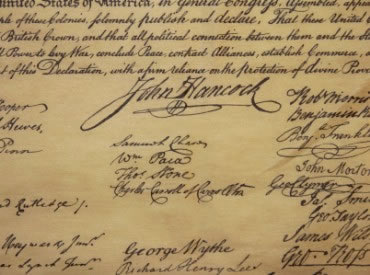John Hancock |
 |
John Hancock was raised by his uncle in Boston, Massachusetts. His uncle sent him to Harvard University and made him a partner in his shipping company. When his uncle died in 1764, John became one of Boston’s most wealthy citizens. In 1765, John was elected to the office of Boston Selectmen. He quickly joined Samuel Adams and the Sons of Liberty and became a strong opponent of the Stamp Act, a tax levied against the colonists by Great Britain. In 1768, John was appointed as a representative of the Massachusetts Legislature. He soon gained the reputation as a strong advocate of American independence. In fact, it was John’s shipping company that enabled the financing and smuggling of goods that supported the region’s resistance to the British. In 1774, one year after Great Britain levied the Intolerable (Coercive) Acts against the colonists, John was elected president of the Massachusetts Provincial Congress, a new Massachusetts legislature which had the authority to call for troops in the wake of a British threat. The British subsequently charged Hancock with treason. In 1775, British troops would march to Lexington with the orders to capture John Hancock. It was during this march that the first shots of the American Revolution were fired. John, along with Samuel Adams, ultimately escaped. Later in 1775, John was appointed president of the Second Continental Congress. It was John Hancock who commissioned George Washington as commander in chief of the Continental Army. On July 4, 1776, John Hancock became the first American to sign the Declaration of Independence. His large, flamboyant signature was by far the most visible of all signatures. According to legend, Hancock signed the document in such a way so that King George II of England could see the signature without his eyeglasses. Throughout the Revolution, the Americans relied on John’s ability to raise funds and supplies for the Continental Army. In 1780, he was elected governor of Massachusetts, a post he held for nine terms. John died in 1793. Today, counties in ten different states are named in his honor. In addition, the tallest building in Boston is named the John Hancock Building. |